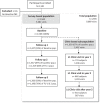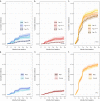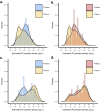Epidemiology of Plasmodium malariae and Plasmodium ovale spp. in Kinshasa Province, Democratic Republic of Congo
- PMID: 37857597
- PMCID: PMC10587068
- DOI: 10.1038/s41467-023-42190-w
Epidemiology of Plasmodium malariae and Plasmodium ovale spp. in Kinshasa Province, Democratic Republic of Congo
Abstract
Reports suggest non-falciparum species are an underappreciated cause of malaria in sub-Saharan Africa but their epidemiology is ill-defined, particularly in highly malaria-endemic regions. We estimated incidence and prevalence of PCR-confirmed non-falciparum and Plasmodium falciparum malaria infections within a longitudinal study conducted in Kinshasa, Democratic Republic of Congo (DRC) between 2015-2017. Children and adults were sampled at biannual household surveys and routine clinic visits. Among 9,089 samples from 1,565 participants, incidences of P. malariae, P. ovale spp., and P. falciparum infections by 1-year were 7.8% (95% CI: 6.4%-9.1%), 4.8% (95% CI: 3.7%-5.9%) and 57.5% (95% CI: 54.4%-60.5%), respectively. Non-falciparum prevalences were higher in school-age children, rural and peri-urban sites, and P. falciparum co-infections. P. falciparum remains the primary driver of malaria in the DRC, though non-falciparum species also pose an infection risk. As P. falciparum interventions gain traction in high-burden settings, continued surveillance and improved understanding of non-falciparum infections are warranted.
© 2023. Springer Nature Limited.
Conflict of interest statement
J.B.P. reports research support from Gilead Sciences, non-financial support from Abbott Laboratories, and consulting for Zymeron Corporation, all outside the scope of this study. The remaining authors declare no competing interests.
Figures






Update of
-
Epidemiology of Plasmodium malariae and Plasmodium ovale spp. in a highly malaria-endemic country: a longitudinal cohort study in Kinshasa Province, Democratic Republic of Congo.medRxiv [Preprint]. 2023 Apr 25:2023.04.20.23288826. doi: 10.1101/2023.04.20.23288826. medRxiv. 2023. Update in: Nat Commun. 2023 Oct 19;14(1):6618. doi: 10.1038/s41467-023-42190-w. PMID: 37790376 Free PMC article. Updated. Preprint.
Similar articles
-
Epidemiology of Plasmodium malariae and Plasmodium ovale spp. in a highly malaria-endemic country: a longitudinal cohort study in Kinshasa Province, Democratic Republic of Congo.medRxiv [Preprint]. 2023 Apr 25:2023.04.20.23288826. doi: 10.1101/2023.04.20.23288826. medRxiv. 2023. Update in: Nat Commun. 2023 Oct 19;14(1):6618. doi: 10.1038/s41467-023-42190-w. PMID: 37790376 Free PMC article. Updated. Preprint.
-
Low prevalence of Plasmodium malariae and Plasmodium ovale mono-infections among children in the Democratic Republic of the Congo: a population-based, cross-sectional study.Malar J. 2016 Jul 8;15:350. doi: 10.1186/s12936-016-1409-0. Malar J. 2016. PMID: 27392905 Free PMC article.
-
School-based malaria prevalence: informative systematic surveillance measure to assess epidemiological impact of malaria control interventions in the Democratic Republic of the Congo.Malar J. 2018 Apr 3;17(1):141. doi: 10.1186/s12936-018-2297-2. Malar J. 2018. PMID: 29615041 Free PMC article.
-
Global trend of Plasmodium malariae and Plasmodium ovale spp. malaria infections in the last two decades (2000-2020): a systematic review and meta-analysis.Parasit Vectors. 2021 Jun 3;14(1):297. doi: 10.1186/s13071-021-04797-0. Parasit Vectors. 2021. PMID: 34082791 Free PMC article.
-
Plasmodium malariae and Plasmodium ovale--the "bashful" malaria parasites.Trends Parasitol. 2007 Jun;23(6):278-83. doi: 10.1016/j.pt.2007.04.009. Epub 2007 Apr 24. Trends Parasitol. 2007. PMID: 17459775 Free PMC article. Review.
Cited by
-
Malaria infection among adults residing in a highly endemic region from the Democratic Republic of the Congo.Malar J. 2024 Mar 18;23(1):82. doi: 10.1186/s12936-024-04881-7. Malar J. 2024. PMID: 38500094 Free PMC article.
-
Seasonal variation and interspecies dynamics among Plasmodium falciparum and ovale species in Bagamoyo, Tanzania.medRxiv [Preprint]. 2025 Mar 13:2025.03.12.25323778. doi: 10.1101/2025.03.12.25323778. medRxiv. 2025. PMID: 40162288 Free PMC article. Preprint.
-
Epidemiology of Relapsing and Falciparum Malaria in the Highlands of Cameroon: An Integrated Community Survey of Human Infection and Vector Abundance.medRxiv [Preprint]. 2025 Apr 28:2025.04.28.25326551. doi: 10.1101/2025.04.28.25326551. medRxiv. 2025. PMID: 40343034 Free PMC article. Preprint.
-
Comparison of SD Bioline Malaria Ag Pf/Pan and Acro Malaria P.f./P.v./Pan with Microscopy and Real Time PCR for the Diagnosis of Human Plasmodium Species.Diagnostics (Basel). 2024 Mar 29;14(7):721. doi: 10.3390/diagnostics14070721. Diagnostics (Basel). 2024. PMID: 38611637 Free PMC article.
-
Detection of P. malariae using a new rapid isothermal amplification lateral flow assay.Malar J. 2024 Apr 12;23(1):104. doi: 10.1186/s12936-024-04928-9. Malar J. 2024. PMID: 38609964 Free PMC article.
References
-
- World Health Organization. World Malaria Report 2021. Genève, Switzerland; 2021. Accessed at https://www.who.int/teams/global-malaria-programme/reports/world-malaria....
-
- Oboh MA, et al. Rising report of Plasmodium vivax in sub-Saharan Africa: implications for malaria elimination agenda. Sci. Afr. 2020;10:e00596.
Publication types
MeSH terms
Grants and funding
LinkOut - more resources
Full Text Sources
Medical
Research Materials
Miscellaneous

